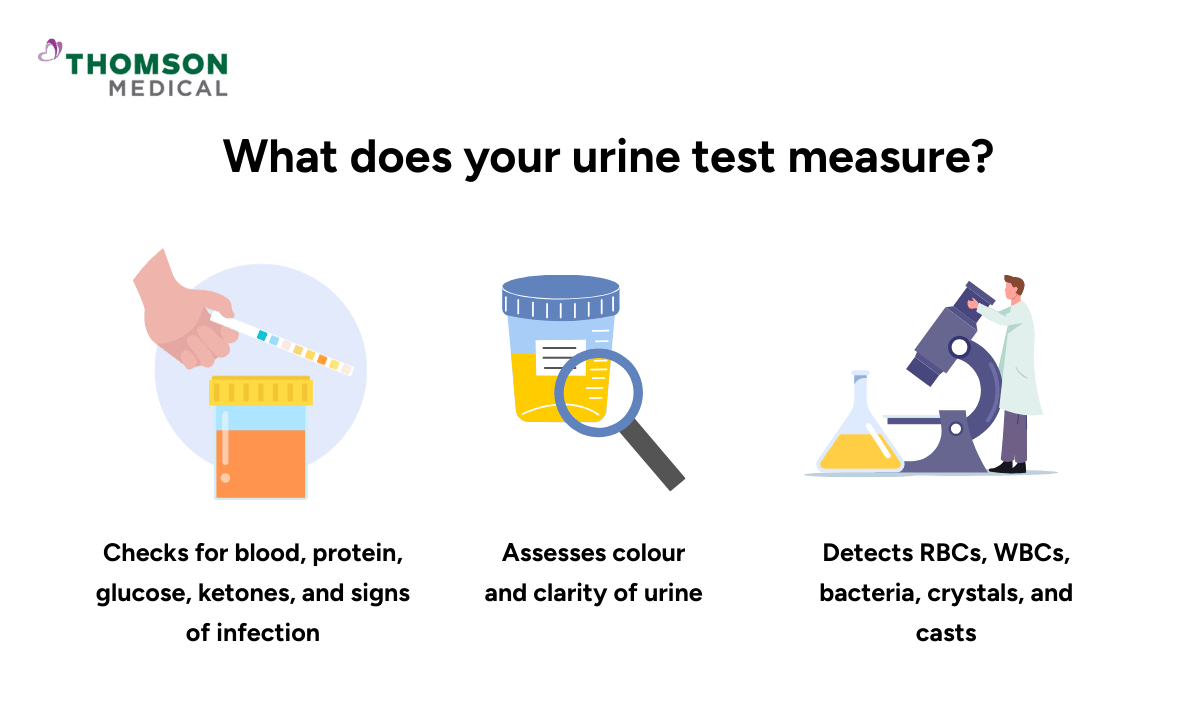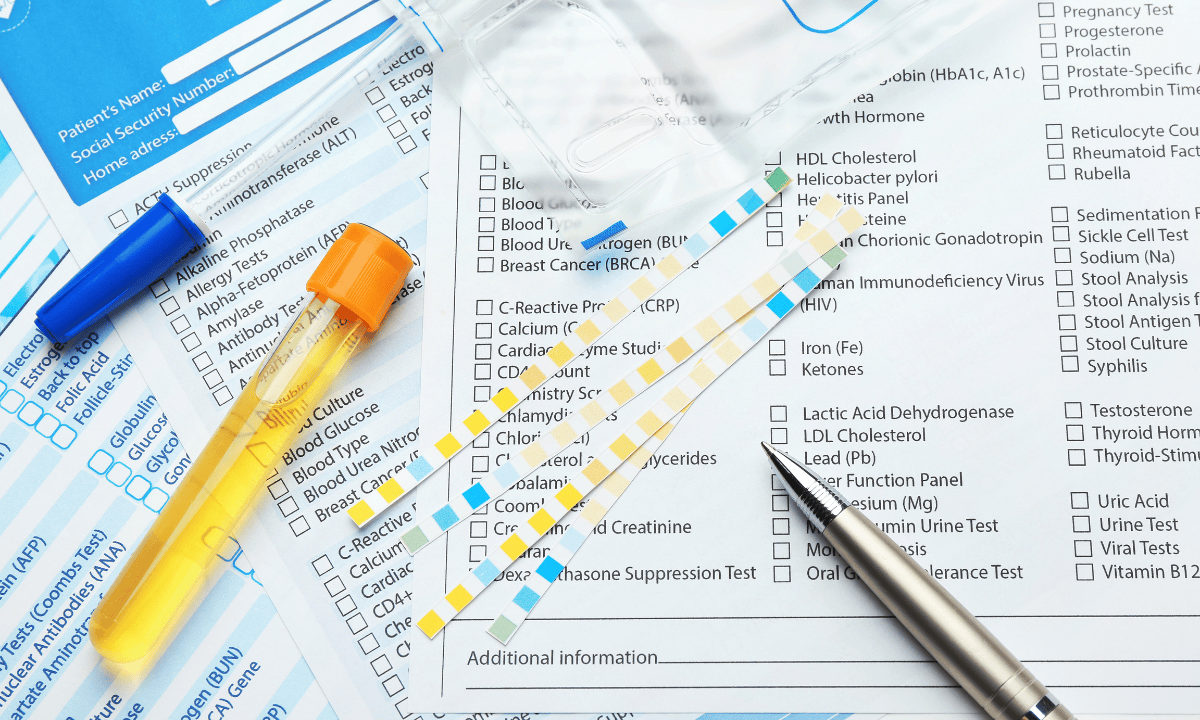What is a urine test?
A urine test, or urinalysis, is a simple medical exam that assesses your urine. When you provide a urine sample, healthcare providers can:
Check the color and appearance of your urine
Test for specific substances that might be present
Look for signs of possible health issues
Your urine can reveal important clues about your health. Doctors often use urine tests to check for:
Possible infections in your urinary tract
How well your kidneys are working
Signs of diabetes
Problems with your liver
Other health conditions
This quick, painless test provides your doctor with valuable information to help monitor your overall health or investigate symptoms you might be experiencing.
What are urine tests used for?
Your doctor might recommend different types of urine tests depending on what they need to check. Here are the main types:
Urine pregnancy test
This common test helps determine if you're pregnant by detecting a special hormone called human chorionic gonadotropin (HCG) in your urine.
You might take this test if you think you could be pregnant, especially if you have missed a period or are noticing early signs of pregnancy such as nausea, tiredness, or breast tenderness.
A urine pregnancy test offers a quick and reliable way to check, either at home or in a clinic setting.
Urinary drug test
A urinary drug test, also known as a urine drug screen, is a test that is done at a healthcare setting to detect the presence of illegal substances or prescription medications in your urine.
Urine drug tests can detect illegal substances such as amphetamines, methamphetamines, benzodiazepines, barbiturates, marijuana, cocaine, PCP, methadone, and opioids.
Healthcare providers, sports athletes, and many employers are required to do urine drug tests regularly.
Urine tests for Sexually Transmitted Infections (STIs)
Some urine tests can help detect certain sexually transmitted infections, especially chlamydia and gonorrhoea. These tests look for the DNA of the bacteria that cause these infections.
It’s important to know that urinalysis tests may not detect all STIs. For example, herpes, trichomoniasis, and human papillomavirus (HPV) often require different types of tests. If you are concerned about STIs, speak to your healthcare team about the most suitable screening options.
If you are experiencing symptoms such as changes in your urine, pain during urination, or concerns about kidney or urinary health, please consult a specialist at Thomson Medical. Request an appointment with Thomson Medical today.
What does the urine test measure?

Your urine test can measure several different things depending on the type of test your doctor orders. Here are the main measurements:
Urine dipstick test
This quick test uses a special paper strip dipped in your urine sample to check for:
Blood:
Might indicate infection, kidney stones, cancer, or sometimes just menstrual contamination
Protein:
Small amounts are normal, but larger amounts could signal UTI, kidney infection, pregnancy complications like pre-eclampsia, or kidney disease
Glucose:
May appear if you have diabetes, kidney disease, or certain inherited conditions
Ketones:
Could indicate diabetic ketoacidosis (a serious emergency for diabetic patients) or dehydration
Bilirubin or urobilinogen:
May suggest liver disease or haemolytic anaemia, in which the red blood cells are being destroyed too quickly.
Leukocyte esterase and nitrite:
Often signs of infection
Visual inspection
Your healthcare provider will check your urine's colour and clarity.
Discoloured or cloudy urine might indicate infection or kidney disease.
Unusual colours can indicate problems with your metabolism.
Microscopic exam
A microscopic urine exam is a detailed test that helps detect kidney issues, urinary tract issues, and other health conditions. During this test, a lab specialist examines your urine sample under a microscope to check for:
Pus cells:
Increased numbers may indicate urinary tract infection (UTI).
Epithelial cells:
These might suggest kidney damage linked to chronic kidney disease or other renal conditions.
Erythrocytes (red blood cells):
This can be due to infections, bleeding in the urinary system, or kidney disease.
Casts:
These tiny tube-shaped particles form in your kidney’s filtering tubes. If found in your urine, it may point to kidney damage or disease.
Crystals:
Certain types of crystal can develop in your urinary tract and sometimes form kidney stones. This often happens due to factors like metabolic issues, certain medications, and even dietary choices.
Bacteria, yeast, and parasites (infections):
Finding bacteria, yeast, or parasites in your urine can be a sign of an infection. This scenario might include a urinary tract infection, a yeast infection, or an STI.
Occasionally, these germs come from outside the urinary tract and can accidentally get into the urine sample.
This type of infection is more common in people with a vagina, where natural bacteria or yeast from the skin or genital area may cause contamination during sample collection.
Albumin-to-creatinine ratio (uACR) test
This test measures the amount of albumin, a type of protein, compared to creatinine, a waste product in your urine.
It helps assess how well your kidneys are working and can detect early kidney damage, especially in people with high blood pressure or diabetes.
Microalbumin test
This procedure is another name for the uACR test and is used interchangeably. It checks for small amounts of albumin in your urine and monitors people at risk of kidney damage, even before symptoms appear.
Urine culture
A urine culture helps identify bacteria in your urine and is used to diagnose urinary tract infections (UTIs). It also shows which antibiotics will work best to treat the infection, allowing your doctor to prescribe the most effective treatment.
24-hour urine test
This test involves collecting all your urine over a full 24-hour period. It provides a detailed overview of how your kidney functions and measures:
Creatinine clearance
Protein levels
Hormones and minerals
Other chemical compounds
This 24-hour urine sample test is used to detect kidney damage, assess hormonal imbalances, and help diagnose chronic kidney disease or other medical conditions.
How do I take a urine sample?
Your healthcare provider will give you a clean, sterile container to collect your urine. To ensure proper collection and avoid contamination, carefully follow these steps:
Wash your hands with soap and water, then dry them with a clean towel.
Remove the lid from the container and be careful not to touch either the inside of the container or the lid.
Clean your genital area using a clean, moist wipe or a clean cloth with soap and water. For people with a vagina, gently separate the genital folds with your fingers and clean from front to back. Dry the area with a clean towel.
Begin urinating into the toilet first. This procedure helps to flush out any bacteria from the urethra.
After the first part of your urine has passed, you can start collecting it by moving the container under the stream and filling the container to about halfway.
Finish urinating into the toilet once you have collected enough urine.
Secure the lid on the container tightly to avoid leaks.
Wash your hands again with soap and water.
Label the collection container with your full name, identification number, the date, and the time you collected the sample.
Return the sample to your healthcare provider or clinic as soon as possible.

Are there any risks from urine tests?
Urine tests are generally very safe and simple. However, there are a few small risks or issues that can affect the accuracy of the results:
Contamination can happen if the sample is not collected properly. Such contamination may lead to inaccurate results or the need to repeat the test.
The risk of infection is extremely low, but it could happen if you don't properly clean the sample before collecting it, as this could introduce bacteria.
Bacterial growth can happen whether the sample is spilt or not stored correctly before testing. This scenario can lead to incorrect results.
To reduce these risks, always follow the instructions given by your healthcare provider when collecting your urine sample.
FAQ
What can be detected in a urine test?
A urine test can detect various conditions related to kidney diseases, such as diabetic kidney disease, urinary tract infections from bacteria or yeast, kidney stones, renal cancers, and urinary tract disorders.
It can also detect conditions other than kidney disorders, such as sexually transmitted diseases, haemolytic anaemia, liver, and bile duct issues. This versatility makes it a useful exam to screen for both kidney and non-kidney disorders.
What are the three types of urine tests?
There are three main types of urine tests:
Visual exam:
This procedure involves checking the colour, clarity, and smell of the urine.
Chemical (dipstick) test:
A specially treated strip is dipped into the urine to check for substances such as pH level, glucose, protein, blood, ketones, nitrites, and white blood cell markers like leukocyte esterase.
Microscopic examination:
A microscope examines a urine sample to identify invisible elements like red and white blood cells, bacteria, crystals, or casts, which are tiny tube-shaped particles.
What is the normal test of urine?
A normal test of urine shows the urine is a pale or yellow colour, clear, odourless, with a pH between 4.5 and 8.0 and negative for glucose, protein, ketones, bilirubin, nitrites, and blood.
A normal urine test result usually shows that the urine is pale yellow, clear, and has no strong smell. The pH should fall between 4.5 and 8.0. There should be no presence of glucose, protein, ketones, bilirubin, nitrites, or blood.
Can I drink water before a urine test?
Yes, you can and should drink water before a urine test to help ensure your bladder is full. However, it’s important not to drink too much water, as overhydration can dilute your urine and potentially affect the accuracy of the results.
How do you know if a urine test is positive?
A positive urine test result typically indicates the presence of abnormal substances in your sample. The indication may appear as a colour change on a dipstick, as a visible marker (such as a line or number), or as results outside of the normal range. For example:
A urinalysis may show high levels of protein, glucose, or blood, which could indicate kidney problems or other health concerns.
A urine culture may detect the presence of bacteria or yeast, which typically suggests a urinary tract infection or another type of infection.
If your test is positive, your healthcare professional will explain the findings and may recommend further testing or treatment.
Can medications affect my urine test results?
Yes, many medications can influence your urine test results. Some may change the colour of your urine or affect chemical levels detected during testing.
Always inform your healthcare provider about all medications you're taking—including prescription drugs, over-the-counter medicines, supplements, and vitamins—before your test. This information helps them interpret your results accurately.
The information provided is intended for general guidance only and should not be considered medical advice. For personalised recommendations and tailored advice, please consult our specialist. Request an appointment with Thomson Medical today.
For more information, contact us:
Thomson Specialists Paragon (Health Screening)
- Mon - Fri: 8.30am - 5.30pm
- Sat: 8.30am - 12.30pm
Call: 6735 0300
See Health Screening Packages
Notice:
The range of services and tests may vary. Please contact us directly to enquire about the current availability.
Book Health Screening